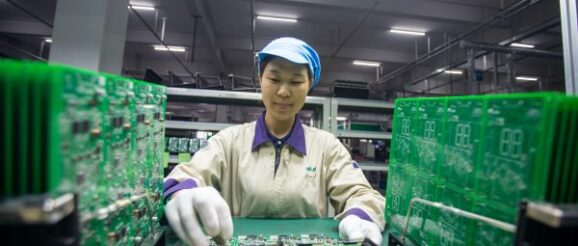What’s at stake in decoupling innovation?

Author: Andrew Kennedy, ANU
Some degree of ‘decoupling’ between the United States and China is already underway, but it remains unclear how far it will go and what it could mean for the world. Much of the analysis so far has focused on the potential decoupling of high-tech supply chains and product markets. Even so, decoupling could also curtail transnational connections between national innovation systems, reshaping how high-tech products and knowledge are created in the first place.
Transnational innovation linkages have become increasingly important in recent decades. Multinationals invest growing sums in global research and development (R&D) networks, scientists increasingly collaborate with colleagues overseas, and ‘brain circulation’ between countries has become entrenched. What would decoupling mean for these growing cross-border connections?
In some regards, China remains a small player in transnational innovation. Between 2000 and 2019, Chinese organisations participated in 12 per cent of all multinational R&D alliances, while US organisations participated in 62 per cent. Foreign firms have also limited their R&D activity in China due to concerns about intellectual property protection, cybersecurity policies, limited local talent and compliance with Chinese standards.
While Chinese firms’ investment in R&D abroad has increased in recent decades, much of this activity reflects the expansion of just one firm — technology giant Huawei. Chinese firms more generally remain marginal players in the innovation systems of OECD countries.
The United Kingdom is a striking example. A remarkable 53 per cent of all business R&D spending in the country came from foreign firms in 2018. Chinese firms accounted for just 2 per cent of this number. US firms accounted for 40 per cent, non-UK European firms made up 29 per cent, and Japanese firms contributed 7 per cent.
China has become a major player in other aspects of transnational innovation, however. China has clearly emerged as a key global partner in basic scientific research. China-based scientists contributed to 23 per cent of the more than 1.5 million scientific articles featuring authors from multiple countries between 2016 and 2019. They were second to only their counterparts in the United States, who contributed to 42 per cent.
China’s rise as a key partner in basic science reflects close collaboration with the United States in particular. China is now the leading source of co-authors for US-based scientists, eclipsing traditional partners like the United Kingdom and Germany. More than 12 per cent all of scientific articles published by US-based scientists from 2016 to 2019 featured a China-based co-author. China-based scientists are also key collaborators for counterparts in Australia, Canada, Japan, and the United Kingdom.
China also plays a critical role in cross-border flows of the ultimate ingredient in innovation: brainpower. The annual number of Chinese students going abroad jumped from 144,000 in 2007 to more than 700,000 in 2019. While many of these students return home after completing their studies, the circulation of Chinese brainpower has also enriched other countries. This is not only because Chinese students spend money in their host countries, but also because Chinese migrants enrich pools of human capital abroad.
In 2015–2016, there were 4.6 million migrants from China in OECD countries, 2 million of which had post-secondary educations — an increase of roughly 300,000 since 2010–2011. This growing pool of mobile human capital contains many of China’s most talented graduates, since China still struggles to bring back its best and brightest.
The United States has been the most obvious beneficiary of the circulation of Chinese brainpower. US universities attract more Chinese students than those of any other country in the world, and many of these students pursue graduate degrees in science and engineering (S&E). Students from China earned 32 per cent of all S&E doctorates awarded to foreign students in the United States between 2000 and 2017.
In addition, most of these new PhD graduates remain in the United States to work. Between 2011 and 2013, 11,000 Chinese students earned doctorates in S&E fields from US universities. As of 2017, 83 per cent of them were still in the country.
The ability of the United States to attract Chinese brainpower is also clearly evident in emerging fields like artificial intelligence (AI). A recent study of top AI researchers trained in China found that three-quarters had moved overseas — and 85 per cent of those abroad were located in the United States.
Whether the United States can continue to compete so successfully for Chinese tech talent is unclear. The country has struggled to manage the coronavirus pandemic and unfriendly policies like the ‘China Initiative’ at the Department of Justice have spread unease among mainland-born Chinese scientists working in the United States.
In short, the stakes of reducing transnational innovation linkages with China are much higher in some regards than in others. China remains a relatively marginal player on the corporate side, whether one is concerned with R&D alliances, foreign R&D in China or Chinese R&D abroad. Nonetheless, China is a key international partner in basic research and in cross-border flows of brainpower.
The benefits of these latter connections do not accrue to China alone. In fact, the United States may well have benefitted more from brain circulation than China has. Accordingly, while developed countries are quite right to take security concerns seriously, they risk shooting themselves in the foot if decoupling goes too far.
Andrew Kennedy is Associate Professor in Policy and Governance at the Crawford School of Public Policy, The Australian National University. He is author of The Conflicted Superpower: America’s Collaboration with China and India in Global Innovation (Columbia University Press, 2018).
The post What’s at stake in decoupling innovation? first appeared on East Asia Forum.
